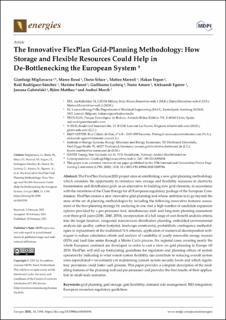| dc.description.abstract | The FlexPlan Horizon2020 project aims at establishing a new grid-planning methodology which considers the opportunity to introduce new storage and flexibility resources in electricity transmission and distribution grids as an alternative to building new grid elements, in accordance with the intentions of the Clean Energy for all Europeans regulatory package of the European Commission. FlexPlan creates a new innovative grid-planning tool whose ambition is to go beyond the state of the art of planning methodologies by including the following innovative features: assessment of the best planning strategy by analysing in one shot a high number of candidate expansion options provided by a pre-processor tool, simultaneous mid- and long-term planning assessment over three grid years (2030, 2040, 2050), incorporation of a full range of cost–benefit analysis criteria into the target function, integrated transmission distribution planning, embedded environmental analysis (air quality, carbon footprint, landscape constraints), probabilistic contingency methodologies in replacement of the traditional N-1 criterion, application of numerical decomposition techniques to reduce calculation efforts and analysis of variability of yearly renewable energy sources (RES) and load time series through a Monte Carlo process. Six regional cases covering nearly the whole European continent are developed in order to cast a view on grid planning in Europe till 2050. FlexPlan will end up formulating guidelines for regulators and planning offices of system operators by indicating to what extent system flexibility can contribute to reducing overall system costs (operational + investment) yet maintaining current system security levels and which regulatory provisions could foster such process. This paper provides a complete description of the modelling features of the planning tool and pre-processor and provides the first results of their application in small-scale scenarios. Keywords: grid planning; grid storage; grid flexibility; demand side management; RES integration; European scenarios; regulatory guidelines | en_US |

